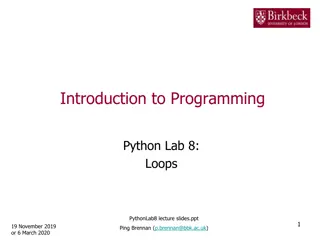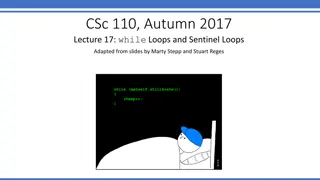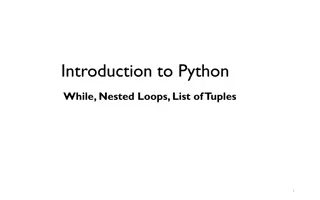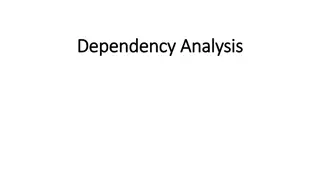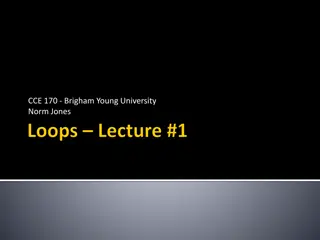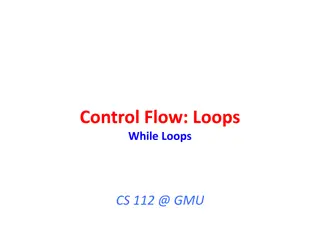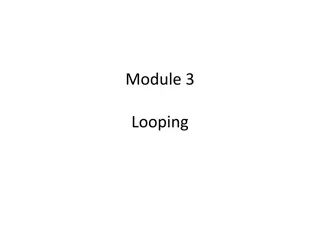
Python For Loops: Simplifying Code Repetition
Learn how to efficiently repeat code multiple times using for loops in Python. Understand the syntax, semantics, and various types of sequences that can be used with for loops, such as lists, strings, and numeric ranges. Master the art of writing definite loops for executing code a specific number of times without resorting to copy-pasting. Enhance your programming skills and streamline your workflow with this essential concept.
Download Presentation

Please find below an Image/Link to download the presentation.
The content on the website is provided AS IS for your information and personal use only. It may not be sold, licensed, or shared on other websites without obtaining consent from the author. If you encounter any issues during the download, it is possible that the publisher has removed the file from their server.
You are allowed to download the files provided on this website for personal or commercial use, subject to the condition that they are used lawfully. All files are the property of their respective owners.
The content on the website is provided AS IS for your information and personal use only. It may not be sold, licensed, or shared on other websites without obtaining consent from the author.
E N D
Presentation Transcript
CS 115 Lecture For loops Taken from notes by Dr. Neil Moore
Repeating yourself What if we wanted to play four rounds of a game? We could write code to play one round, but We need to do that four times each with different inputs and results each time. Do we need to copy-and-paste the code 4 times?
Repeating yourself Do we need to copy-and-paste the code 4 times? No! Loops allow you to execute code multiple times. with a variable that is different each time Two kinds of loops: definite and indefinite Definite loops know in advance now many times to run Indefinite loops run until some condition is satisfied Today we ll see how to write definite loops in Python
The for loop Syntax: for var in sequence: Followed by a block (collection of indented lines) called the body. The body must be indented more than the for line! var is an identifier (variable name) Semantics; Execute the body once for each item in the sequence Each time, the variable var will have the value of that item Each run of the body is called an iteration.
The for loop A very simple for loop: for color in [ red , green , blue ]: print(color, is a primary color. ) We give a list in square brackets for the sequence When executed, it does: Iteration 1: red is a primary color Iteration 2: green is a primary color Iteration 3: blue is a primary color
Other kinds of sequences Strings can be used as sequences. Each iteration of the loop operates on a single character: name = input( What is your name? ) for char in name: print(char) Prints this: J o h n
Numeric ranges One of the most common, and most useful, kinds of sequences for a for loop is a numeric range. In Python, you create numeric ranges with the range function. It always creates integers. There are three ways to call range: range(3): counts from 0 up to 2 Computer scientists usually count from zero, not one Goes up to but not including the final number (just like randrange!) for i in range(3): print(i, squared is , i**2) prints: 0 squared is 0 1 squared is 1 2 squared is 2 Note the loop ran 3 times (for i = 0, 1, and 2) Don t make a fencepost error!
Range variations We can also tell range to start at a different number: Syntax: range(start, stop) Produces a sequence of integers from start to stop Includes the start number (inclusive), does NOT include the stop number (exclusive) for i in range(3, 6): print(i) prints: 3 4 5 Runs for (stop start) iterations
Variations on range What if we wrote range(1, 1)? It gives an empty sequence: stops before getting to 1 The loop won t run at all! Loops can run for 0 iterations! Similarly, range(5, 1) is an empty sequence for i in range(5, 1): print(i) The body never executes (is dead code)
Counting with steps The last variation on range: We can count by steps bigger than 1, only considering every nth number: Syntax: range(start, stop, step) Instead of adding 1 in each iteration, adds step. The first number is still start The next number is start + step, then start + 2*step,
Counting with steps What will this do? for i in range(10, 25, 5): print(i) Prints: 10 15 20 Does not include 25, the stop number is still exclusive. What about range(10, 2) ? # common error! Since there are only two arguments, it means start at 10 and stop at 2, NOT start at 0, stop at 10 and step 2!
Counting backwards You can count down by providing a negative step. for i in range(3, 0, -1): print( Counting down: , i) print( Lift off! ) Prints: Counting down: 3 Counting down: 2 Counting down: 1 Lift off! The stop number is still exclusive (not included)! range(1, 5, -1) is an empty sequence
Finding an average Suppose we have a collection of measurements in a list and we want to find their average: add them all up and divide by the number of measurements: temperatures = [67.0, 69.2, 55.3, 71.2, 65.4] We can get the number of measurements by a function called len: len(temperatures) For the sum, we need some kind of a loop for temp in temperatures: We need to add another number in each iteration We need a variable to keep track of the sum We call such a variable an accumulator Accumulators are NOT new syntax Just a new way of using assignment A logical concept, used in most programming languages
Accumulators The general pattern of accumulators: Make an accumulator variable to hold the total Like the display on a calculator Before the loop starts, initialize the accumulator to a known value Like clearing out the calculator first If we are calculating a sum, start at 0 total = 0 0 is the identity for addition: adding 0 to a number doesn t change it
Accumulators Inside the loop, use assignment to update the accumulator for temp in temperatures: total = total + temp Or use augmented assignment: total += temp What if we don t initialize total first? NameError: name total is not defined
Accumulators Accumulators can be used for more than just adding bunches of numbers. Choose the initial value carefully so it doesn t change the result Factorial: 1, 2 = (1 x 2), 6 = (1 x 2 x 3), Inside the loop we will multiply the accumulator If we started the accumulator at zero, we d never get anything but zero!
Accumulators The multiplicative identity is 1, use that. factorial = 1 for I in range (1, max + 1): factorial *= i Counting: how many times does something happen? Just like sum: initialize with zero. Instead of adding I, just add 1. numoff = 0 for i in range(1, 100, 2) numodd += 1 We call an accumulator like this a counter.
More accumulators Reversing a string Our accumulator will be a string We ll loop over the characters of the input string Concatenate each new character to the beginning of the accumulator string What is the identity element for concatenation? (That is, what can you concatenate with, without changing the original string?) The empty string!
Reversing a string instr = input( enter a string: ) reversed = for char in instr: reversed = char + reversed print(instr, backwards is , reversed) See reverse.py
Previous-current loop Sometimes a loop needs two items from a sequence at one time Drawing lines (needs 2 points at once), computing distances Or to see if user input has changed We can save the previous item in a variable 1. Initialize prev 2. Loop: 1. curr = the new item 2. Do something with prev and curr 3. prev = curr In the first iteration, prev is the initial value On following iterations, prev is the value from the preceding iteration
Tracing code Code with loops, several variables, etc. can get complicated It s good to know what it will do before running it Trial and error is good for practice and experimentation Not so good for making working, bug-free code We ll learn several debugging techniques in class One of the simplest and most useful is tracing Also known as a desk check Run through code line-by-line, simulating its behavior Keep track of the variables (RAM) and output Pretend you are the interpreter and you are NOT SMART!
Are the data in ascending order? Example of prev/curr pattern You need to compare two pieces of data at a time in_order = True prev = int(input( enter some data )) for i in range(5): curr = int(input( Enter some data )) if prev > curr: in_order = False if in_order: print( all were in order ) else: print( at least one pair was out of order )
Tracing a previous-current loop 1. 2. prev = get mouse for i in range(2): 3. curr = get mouse 4. draw line from prev to curr 5. prev = curr Line i prev curr output 1 ---- (50, 50) ---- 2 0 (50, 50) ---- 3 0 (50, 50) (400, 50) 4 0 (50, 50) (400, 50) One Line 5 0 (400, 50) (400, 50) 2 1 (400, 50) (400, 50) 3 1 (400, 50) (200, 300) 4 1 (400, 50) (200, 300) Another line 5 1 (200, 300) (200, 300)

